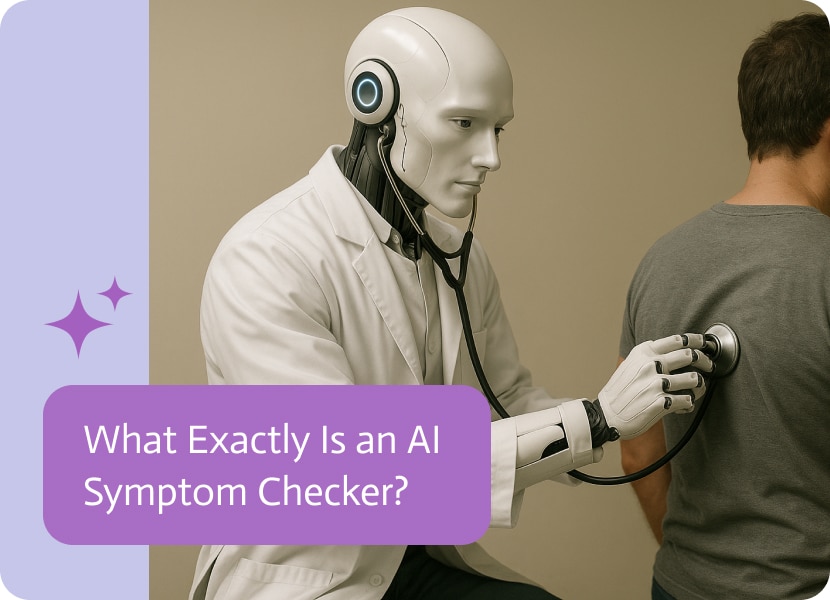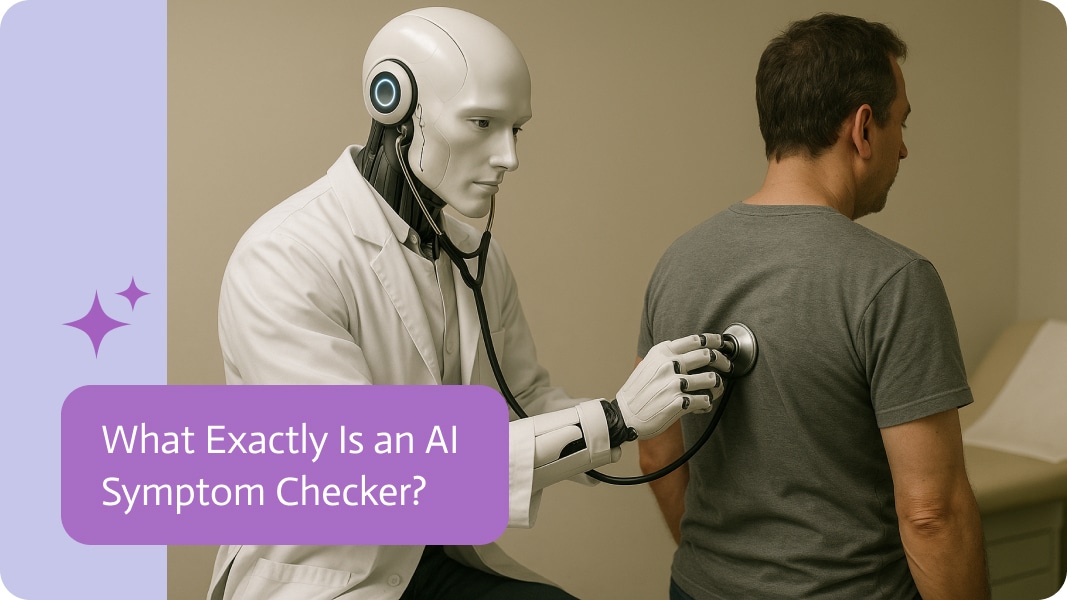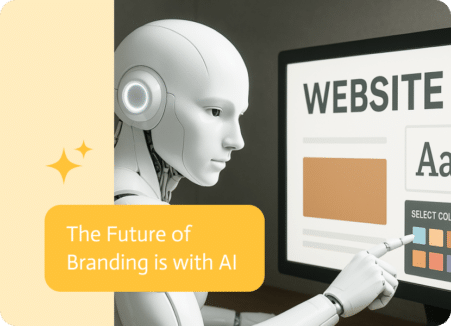

What Exactly Is an AI Symptom Checker?
An AI symptom checker is a digital tool that uses artificial intelligence and medical knowledge to help you figure out what might be causing your symptoms. You type in what you’re feeling (“sore throat,” “chills,” “weird muscle cramps”), and the AI does the heavy lifting, analyzing millions of data points, comparing symptoms with known medical conditions, and spitting out a list of possible causes or suggestions.
It’s like a virtual first opinion, smart, fast, and available 24/7.
How Does It Actually Work?
Think of it as a mini diagnostic engine in your pocket. Here’s a simplified breakdown of how it typically works:
- Symptom Input
You enter what you’re experiencing; maybe it’s “nausea,” “back pain,” or “fever for 3 days.” - AI Analysis Begins
The system compares your symptoms to vast medical databases, case studies, and symptom patterns using machine learning models. - Pattern Matching + Risk Assessment
It narrows down potential conditions, often ranked by likelihood and urgency. For instance:
- 40% chance of viral infection
- 30% chance of food poisoning
- 5% chance of something more serious
- Recommendation or Triage
The AI might tell you:
- “Drink fluids and rest, low urgency.”
- “Schedule a doctor’s visit within 24 hours.”
- “Go to the ER immediately.”
Some tools even escalate things directly, linking you to a telehealth provider or scheduling a virtual consult.
What Makes It AI?
When folks say an app is powered by AI, here’s what they usually mean.
Natural Language Processing
NLP lets you type, I feel dizzy, and my head is spinning. The program catches the mood, not just the buzzwords.
Machine Learning
Every new patient record that lands in the system helps the software get sharper at spotting patterns and guessing what might come next.
Medical Knowledge Graphs
The best symptom checkers lean on huge, structured maps of illnesses, signs, drugs, and possible outcomes. These maps can link a rare rash to even rarer diseases that most humans or a few tired doctors would miss.
Popular Symptom Checkers You’ve Probably Met
- WebMD Symptom Checker: The old standby that has picked up some AI muscle over the years.
- Ada Health: Chatty, tidy, and surprisingly well-traveled across different countries.
- Buoy Health: Runs like a quick Q&A chatbot and pushes you toward the right level of care.
- K Health: Digs into what thousands of everyday patients have reported, then mirrors that back to you.
- Babylon Health: Spins simple checks into full-blown video visits with real doctors.
- Mayo Clinic Symptom Checker: Twins expert knowledge with a no-frills Q&A interface that feels trustworthy.
Each of these tools speaks its own language and digs to different depths, but they all promise the same perk: fast, tailored ideas about what might be bothering you.
The Good Stuff: Why People Use Them
There’s nothing flashy about clicking a few buttons late at night, yet that small act often feels like a borrowed superpower.
Always On Call.
It’s 3 a.m. and your throat is scratchy; the screen lights up without judging, just waiting for you to type.
Speeds Up Care Decisions.
The little chat box usually answers whether you should chill out on the couch or find an open ER.
Reduces Anxiety (Sometimes).
Parents pacing the hall or the occasional hypochondriac (yes, we see you) often relax once the tool says, Probably nothing big.
Helps Doctors, Too.
Crowded clinics sometimes give the same symptom checker a whirl to sort out who really needs to be seen first.
The Caveats: Where AI Falls Short
Don’t hand the program your pulse and walk away satisfied; it isn’t a magic wand.
1. It’s Not a Doctor.
Only a human can write a prescription, explain a lab result, or deliver the empathic nod we sometimes need.
2. Data Quality Matters.
Miss a detail or misremember a symptom, and the answer might lead you off course faster than you can hit refresh.
3. Overwhelming or Alarmist.
One minute you’re scanning helpful tips, and the next the screen whispers worst-case terms like cancer, and suddenly your heart races more than it should.
4. Equity and Access Gaps
Not every app speaks the same language; sometimes, even literal languages matter, and what makes sense to one group may confuse another. Health literacy is still a huge swing set: some people sit at the top, others barely reach the bottom bar, and no tool seems to adjust for that gap.
Real-World Use Cases
Bring it down to earth for a second. Picture a mom wide awake at 3 AM, flashlight on her forehead, asking an app if her toddler’s 102F fever is a ‘wait’ or a ‘go.’
Try a college kid traveling through street-food heaven, nervously typing whether stomach cramps equal food poisoning or just last night’s stall special.
Workers on the clock might sneak a check in a chat window, simply wanting to see if that relentless headache qualifies for an early out. Even clinics and insurers are planting these checkers in their portals, seeing them less like gadgets and more like digital first-aid kits.
What’s Next for AI Symptom Checkers?
The crystal ball says smarter stuff is on the way. Imagine an AI that glances at your profile, including that dodgy biopsy from two years back, and spits out guidance that feels almost custom-made.
Maybe tomorrow’s voice assistant will blurt, ‘I see your allergy meds are overdue,’ while you’re busy mixing breakfast instead of booming out vague medical jargon.
Smartwatches could pipe up, ‘Heart rate is up 140; want me to ask the checker?’ nudging you before you even hit send on an email. And yes, the bet behind those scenes is that regulation will catch fast-tracking many of these tools through the same FDA hoops that give a drug its gold-star trust.
Before long, your smartphone or smartwatch could turn into a full-time health buddy. It might nudge you, check your numbers, and coach you to make smarter choices without a single stethoscope in sight.
Final Thoughts: Helpful, Not a Replacement
AI symptom checkers aren’t here to replace doctors; they’re here to help us make better decisions faster. Think of them as the Google Maps of health: not perfect, but way better than guessing.
Used wisely, they empower us to:
- Ask better questions
- Take control of our health
- Avoid unnecessary panic (or, in some cases, unnecessary waiting)
The key? Treat them as a first step, a helpful nudge in the right direction, not the final word. Just like any tool, the real power comes when humans and technology work together.


